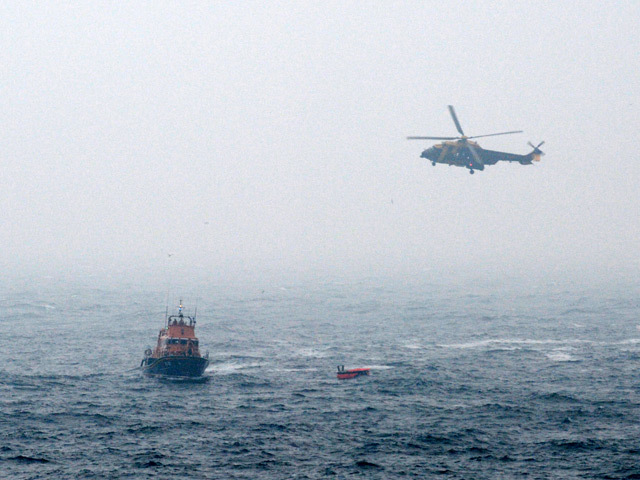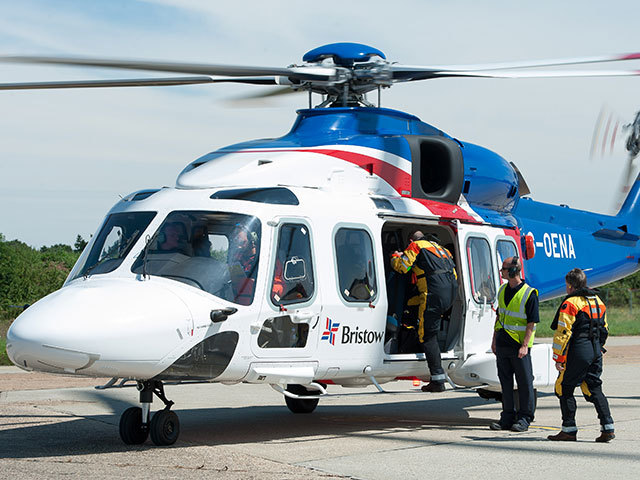
Four people who died after a helicopter ditched in the sea off Shetland have been named this morning.
Duncan Munro, 46, from Bishop Auckland, 45-year-old Sarah Darnley from Elgin, 59-year-old Gary McCrossan from Inverness, and George Allison, 57, from Winchester lost their lives after the CHC helicopter dropped into the sea off Fitful Head.
So far the bodies of three of the fatalities have been recovered. A fourth person remains unaccounted for, a spokeswoman for Police Scotland said.
A major rescue operation was launched when the aircraft – believed to be a Super Puma L2 – came down two miles west of Sumburgh and flipped over in the water.
It had been travelling from the Borgsten Dolphin rig and was flying for oil giant Total.
An RNLI spokesman said two of the bodies were recovered by an RNLI lifeboat crew from Lerwick, Shetland.
“The lifeboat crew transported the bodies to Sumburgh and we are liaising with other authorities as things develop, ” he said.
“Obviously this is the news that everyone, included our lifeboat volunteers, dreaded – our thoughts and prayers are with the families and loved ones of those concerned.
“We can also confirm that one of our lifeboats has also been involved in reclaiming wreckage from the scene as part of the operation.”
A police spokeswoman confirmed that 14 of the 18 people on board the helicopter were taken to safety during the immediate rescue response last night.
The coastguard had earlier believed the figure was 15.
READ MORE:
Jeremy Cresswell: We want answers over latest Super Puma failure
Industry chief ‘deeply concerned’ by new helicopter incident
Timeline: North Sea helicopter accidents
Jim Nicholson, RNLI rescue co-ordinator, said he understands two of the bodies were recovered in the area where the helicopter crashed.
“The bodies came to the surface close to the helicopter wreckage,” he said.
“The helicopter was in a pretty inaccessible place but the lifeboat crew were able to get to them using an inflatable craft.
“It’s fortunate there were not more casualties in a helicopter crash of this kind.
“There appears to have been a catastrophic loss of power which meant the helicopter suddenly dropped into the sea without any opportunity to make a controlled landing.”
The rescue team then spent hours securing the helicopter and moving it to a more accessible location where it is waiting to be loaded on to a vessel.
Mr Nicholson added: “The helicopter is being held in position but no one has been able to board it yet.
“Once the helicopter has been loaded on to the vessel it can searched.
“It may be that a body is recovered on the helicopter.”
Last night Shetland councillor Allison Duncan went down the shoreline to speak to rescuers at the scene.
“Of the 15 accounted for, one was a fatality – that was confirmed to me by a member of the coastguard team,” he said.
And last night another north-east operator, Bond Offshore Helicopters, grounded all of its Super Pumas until further notice.
A spokesman said: “We are aware of the incident off Shetland and our thoughts are with those involved.
“At this time, and until we have further information, Bond Offshore Helicopters will not be operating any of its Super Puma aircraft fleet, with the exception of our Jigsaw rescue aircraft, which are actively involved in providing assistance.”
There were 18 people on board the CHC craft when the incident happened shortly after 6.15pm. A total of 15 people have been accounted for and taken to the emergency landing site at Clickimin at Lerwick.
Unconfirmed reports indicted that the aircraft had lost power, dropped and rolled in the water and the 16 passengers and two crew had “no time to brace”.
Michael Bull, whose son Samuel was among those rescued, said: “We understand he was on his way back from a rig and the helicopter lost power suddenly and immediately ditched into the water.
“He managed to escape straight away because he was right by an exit and I understand soon afterwards that the helicopter turned over.”
It was understood the casualties – one on a stretcher – had been taken to Gilbert Bain Hospital at Lerwick.
The coastguard said wreckage from the helicopter was starting to wash up at Garths Ness near Sumburgh Head.
An RNLI spokesman said: “Some wreckage has been seen in the sea. The lifeboat crew has said the tides are quite strong and there is poor visibility in the area. That is what they are up against.”
A police spokesman said: “Maritime and Coastguard Agency are co-ordinating the search-and-rescue operation following a helicopter having gone down off the coast of Shetland shortly before 6.30pm tonight.
“A total of 18 people were reported to be on board the helicopter, which went down two miles off the coast of Sumburgh.
“The search is currently ongoing involving a number of agencies, co-ordinated by MCA, and so far 15 people have been uplifted to Gilbert Bain Hospital in Lerwick.
“Sumburgh Airport is currently closed to allow emergency services to deal with the ongoing incident.
“A major incident has been declared and agencies are working closely in partnership.”
 A Coastguard search-and-rescue helicopter, as well as the lifeboats from Lerwick and Aith, were at the scene.
A Coastguard search-and-rescue helicopter, as well as the lifeboats from Lerwick and Aith, were at the scene.
The NorthLink ferry Hjaltland was initially diverted to the scene and had been providing communications facilities for the rescue operation. The passenger boat, thought to have been carrying up to 100 passengers, was about eight miles off Sumburgh Head when she received the mayday call. But late last night the vessel resumed her normal service heading for Kirkwall.
A CHC Helicopter spokeswoman said: “We can confirm that an L2 aircraft has landed in the water approximately two miles west of Sumburgh.
“The aircraft was on approach to Sumburgh Airport at approximately 6.20pm when contact was lost with air traffic control.
“We can confirm there were 16 passengers on board and two crew.”
The oil-industry Jigsaw helicopter was also on the scene, as were the two Shetland lifeboats, the NorthLink cargo boat Helliar and the salmon-carrier Gerda Saele.
BP’s Project Jigsaw is a £25million-a-year search and rescue project which covers 12 offshore installations.
The scheme, launched in 2006, relies on two Super Puma AS332L2 helicopters, operated by Bond out of Sumburgh on Shetland and BP’s Miller platform, plus four regional support vessels.
The search was being hampered by extremely poor visibility, reported to be down to less than 50 yards.
Bond Offshore Helicopters had two search and rescue helicopters up and searching for passengers and crew, alongside the Coastguard search and rescue teams.
A spokesman said: “The Bond crews used their own paramedic skills to assist those that they picked up by from the sea and took back to land.
“The helicopters were expected to continue flying through the night, for as long as they were required in the search for the three missing men and as long as the weather allowed.”
NorthLink ferries said the Coastguard was in the lead of the operation but one of its ferries had been assisting.
The ditching site is relatively near the coast, off Fitful Head, at the south end of Shetland, quite close to the site where the tanker Braer ran aground in January 1993.
Recommended for you
